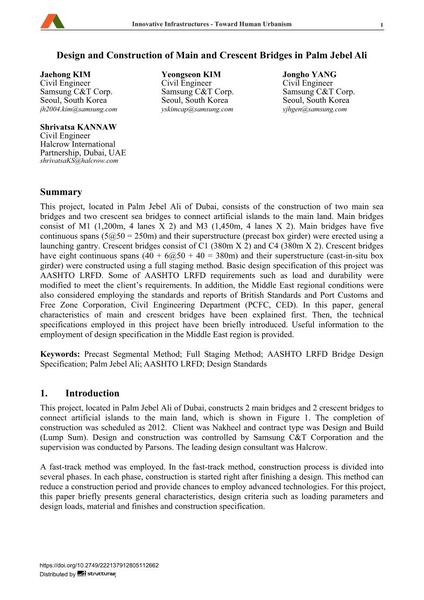Design and Construction of Main and Crescent Bridges in Palm Jebel Ali

|
|
|||||||||||
Détails bibliographiques
| Auteur(s): |
Jaehong Kim
Yeongseon Kim Jongho Yang Shrivatsa Kannaw |
||||
|---|---|---|---|---|---|
| Médium: | papier de conférence | ||||
| Langue(s): | anglais | ||||
| Conférence: | 18th IABSE Congress: Innovative Infrastructures – Towards Human Urbanism, Seoul, Korea, 19-21 September 2012 | ||||
| Publié dans: | IABSE Congress Seoul 2012 | ||||
|
|||||
| Page(s): | 1874-1881 | ||||
| Nombre total de pages (du PDF): | 8 | ||||
| DOI: | 10.2749/222137912805112662 | ||||
| Abstrait: |
This project, located in Palm Jebel Ali of Dubai, consists of the construction of two main sea bridges and two crescent sea bridges to connect artificial islands to the main land. Main bridges consist of M1 (1,200m, 4 lanes X 2) and M3 (1,450m, 4 lanes X 2). Main bridges have five continuous spans (5@50 = 250m) and their superstructure (precast box girder) were erected using a launching gantry. Crescent bridges consist of C1 (380m X 2) and C4 (380m X 2). Crescent bridges have eight continuous spans (40 + 6@50 + 40 = 380m) and their superstructure (cast-in-situ box girder) were constructed using a full staging method. Basic design specification of this project was AASHTO LRFD. Some of AASHTO LRFD requirements such as load and durability were modified to meet the client’s requirements. In addition, the Middle East regional conditions were also considered employing the standards and reports of British Standards and Port Customs and Free Zone Corporation, Civil Engineering Department (PCFC, CED). In this paper, general characteristics of main and crescent bridges have been explained first. Then, the technical specifications employed in this project have been briefly introduced. Useful information to the employment of design specification in the Middle East region is provided. |
||||
